Intel has told about the fifth generation Core processors
SoC Cherry Trail shipments were launched.
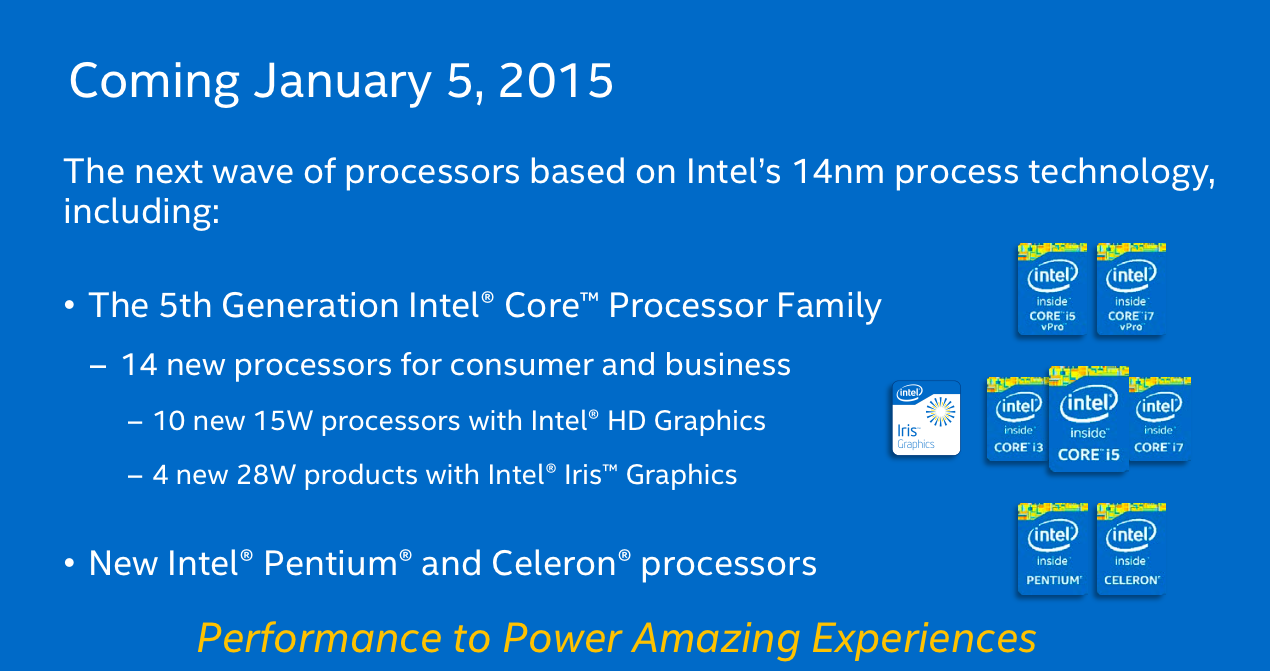
Intel representatives said that in early 2015 more microprocessors will be shown on the new Broadwell architecture, and they kept their promise.
On January 5, at the International Consumer Electronics Show in Las Vegas, 17 new dual core processors were announced right away - from the expensive Core i7 to the more affordable Pentium and Celeron. It was worth waiting for - half a year had passed after the announcement of the first Core M chips with a 14-nm process technology.
')
Usually, Intel first presents expensive models, and later, at the expense of cost reduction, it sets up the release of cheaper solutions. But in the case of Broadwell, for some reason, we first decided to show dual-core microprocessors for low-cost devices, and there will not be fast quad-core chips that require more power until summer.
So, what we got yesterday, and what to expect in the future.

Intel remains committed to the tick-to-do strategy. "Tick" is a reduction in technical process, "so" means a new architecture. The novelties presented yesterday are “tick”.
| Year | Microarchitecture code name | Technical process | Branding | "Tick" or "so" |
|---|---|---|---|---|
| 2010 | Westmere | 32 nm | Core i3 / i5 / i7 | "Teak" |
| 2011 | Sandy bridge | 32 nm | Second generation i3 / i5 / i7 | "So" |
| 2012 | Ivy bridge | 22 nm | Third generation i3 / i5 / i7 | "Teak" |
| 2013 | Haswell | 22 nm | 4th generation i3 / i5 / i7 | "So" |
| 2014—2015 | Broadwell | 14 nm | Fifth Generation i3 / i5 / i7, Core M | "Teak" |
| 2015? | Skylake | 14 nm | - | "So" |
The first of the Broadwells were several Core M models last year. These microprocessors have the letter Y in the name, and this is not the flagship of Intel, only Atoms are weaker than them. The microprocessors announced yesterday are a more powerful U-series.
Most of the new products have a heat output of 15 watts, although there are productive versions with a capacity of 28 watts. Haswell had similar performance. Intel points out that when manufacturers are reluctant to create new systems from scratch, they can use Broadwell microprocessors in Haswell systems.
The most common chips are 15-watt i3, i5 and i7, which will most often appear in ultrabooks and even desktop computers, in which size and weight are important. Pentium and Celeron will be used in more budget solutions. One such Celeron has already lit up in the Lenovo ThinkPad.
But the new microprocessors for desktop systems - those with heat dissipation above 45 watts - will be shown no earlier than mid-2015.
The crystal size is reduced by 37%, while at the same time 35% more transistors mix in it. Intel promises that the new Broadwell micro-architecture can increase the battery life by one and a half hours (from 45 minutes to 2 hours) relative to its predecessor Haswell. However, for the consumer, this may mean a new round of the race for thickness, and not longer working electronics.

Somewhat improved performance. For example, the i7-5600U operating frequency is 2.4 GHz, for i7-4600U, this parameter is 1.8 GHz and 2 GHz for i7-4610U.
Below to heighten the effect, Intel compares the new product with a four-year-old i5-520UM processor. This is, in general, correct - a typical consumer changes a laptop every few years, and not with the advent of a new micro-architecture.
This step has to be taken, since the performance relative to Haswell has grown by only 4%, as can be seen from the slide above. And there is nothing strange in this - computational power basically improves “so” and not “tick”.
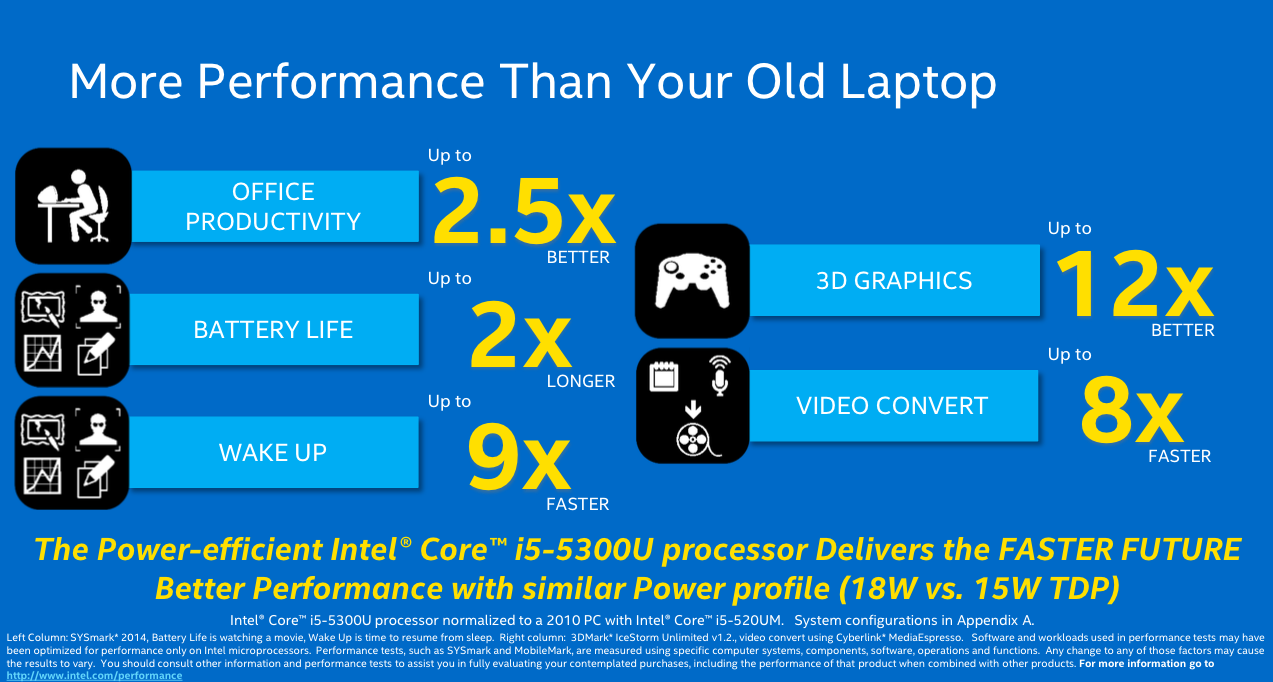
Much more interesting is the improvement of graphics. As you can see in the illustration below, it takes up almost two thirds of the chip. The situation gradually changed from four to five years ago when it was silly for a gamer to rely on the integrated graphics.

| Haswell Graphics | Executive units | Peak frequency | Substitution in Broadwell | Executive units | Peak frequency |
|---|---|---|---|---|---|
| Intel Iris 5100 (28W GT3) | 40 | 1100-1200 MHz | Intel Iris 6100 (28W GT3) | 48 | 1000-1100 MHz |
| Intel HD 5000 (GT3) | 40 | 1000-1100 MHz | Intel HD 6000 (GT3) | 48 | 950-1000 MHz |
| Intel HD 4400 (GT2) | 20 | 950-1100 MHz | Intel HD 5500 (GT2) | 24 | 850-950 MHz |
| Intel HD 4200 (GT2) | 20 | 850 MHz | Intel HD 5300 (GT2) | 24 | 800–850 MHz |
| Intel HD Graphics (GT1) | ten | 1000 MHz | Intel HD Graphics (GT1) | 12 | 800 MHz |
As can be seen from the table above, four new GPUs were presented. The eDRAM L4 cache remains the same. Everyone has the same architecture, but a different level of performance. The most powerful are the Iris 6100 and HD 6000, which replace the Iris 5100 and HD 5000. Both solutions Intel calls the GT3, the difference is only in frequency. Iris 6100 stands in 28-watt processors.
The Intel HD 5500 replaces the HD 4400. It has 24 execution units and supports LPDDR3 and DDR3L 1600 MHz RAM, while the HD6000 supports 1866 MHz LPDDR3 and 1600 MHz DDR3L. Integrated graphics are often limited precisely by the frequency of the memory, so this difference can play an important role in video games.
The bottom lines are occupied by the weakest GT1 or Intel HD Graphics with 12 execution units. It uses the same architecture as its older cousins, which means the similarity of the API. Unlike Haswell, now even the cheapest Pentium and Celeron models have Wireless Display and Quick Sync.
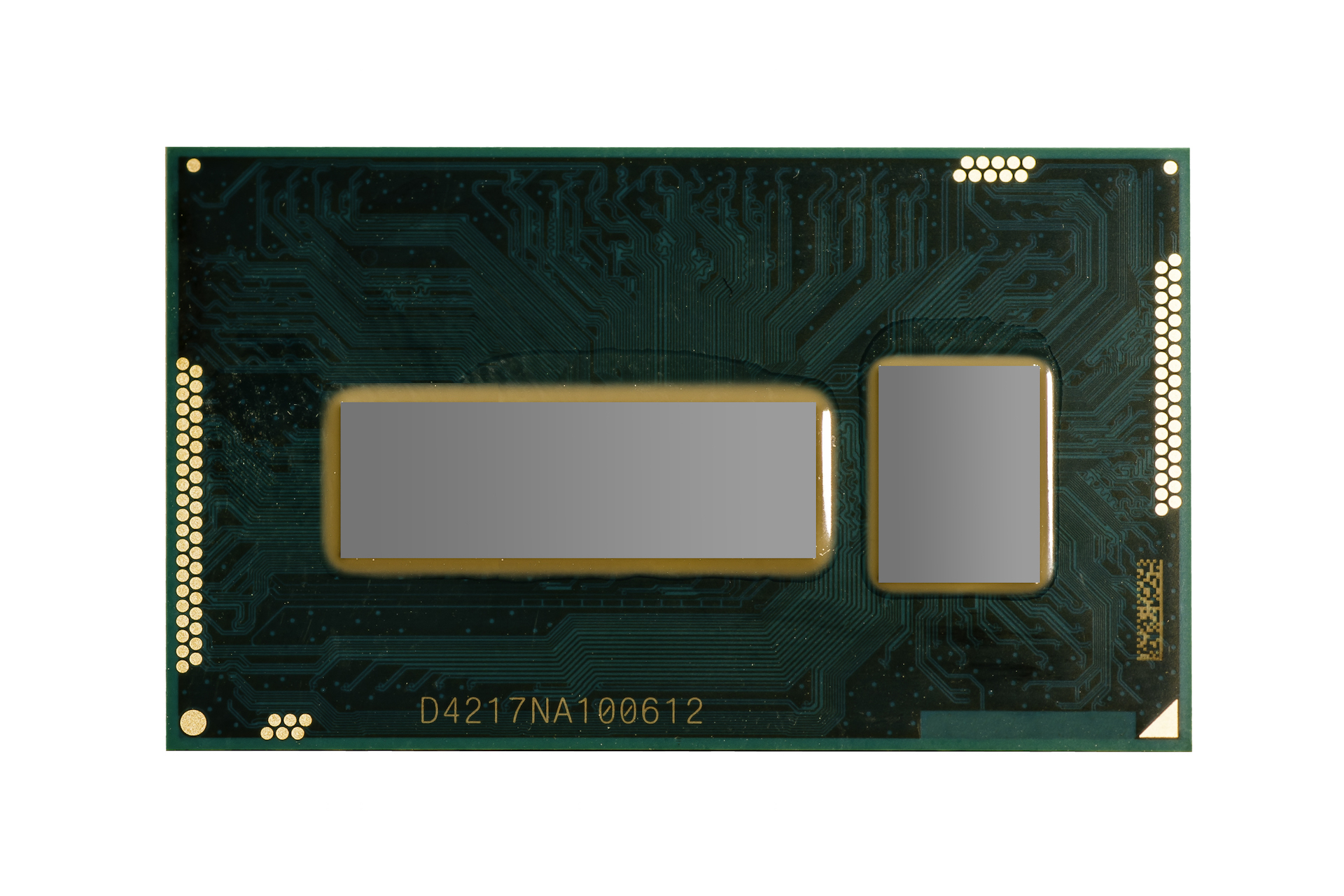
Photographic processor GT3 Broadwell. The box on the left is the processor and graphics, on the right is the chipset.
Improvements relate not only to reducing the size of the elements, and with it - and energy consumption. Broadwell microprocessors support DirectX 11.2 (Intel promises DirectX 12 later), OpenGL 4.3 and OpenCL 2.0.
GT3 and GT2 support monitors with a resolution of 3840 × 2160 with a frequency of 60 Hz on DisplayPort 1.2. Haswell could give out only 30 Hz. All processors are able to encode and decode H.265 4K-picture at 30 frames per second. Added support for VP8, JPEG and MJPEG decoding.
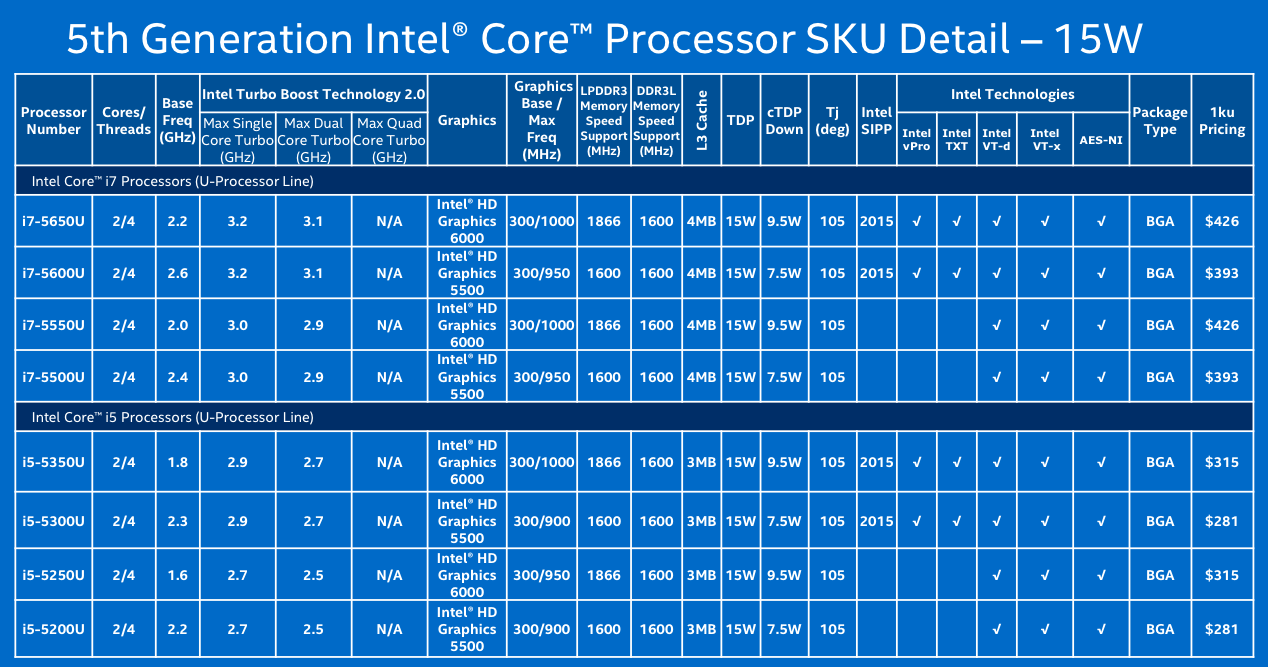


Four Core i7 models and four 15-watt Core i5 models were presented. Available in versions with HD 6000 and HD 5500. The power consumption of the former can drop to 9.5 watts, the latter - 7.5 watts. The i3, Pentium and Celeron models do not have vPro technology support. Pentium and Celeron use quite basic Intel HD Graphics and little cache, but have the same heat dissipation parameters. 28-watt processors differ in frequency, cache size, but have the same graphics. None of them have vPro support.
In addition to the processors themselves, the chipset has also been updated. It has native support for drives connected via the PCI Express bus. Most often it is a hard core for which the standard SATA is too narrow.
Cherry trail
On January 5, Intel shared information not only about the Broadwell microarchitecture processors, but also about the Cherry Trail chip. This is a single-chip system for tablets running Windows and Android.
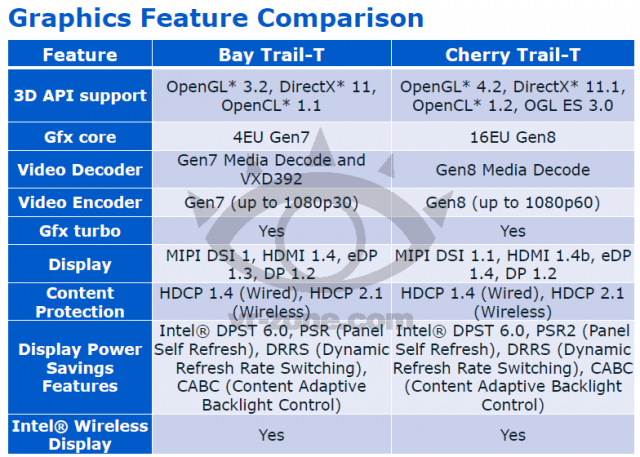
Cherry Trail, like the new fifth-generation Intel Core microprocessors, uses a 14nm process technology. Initially, there were problems with marriage in production, because of this, the issue had to be postponed for several months.
Innovations are not limited to nanometers of the technological process. First, the Airmont processor architecture is used, which is an enhancement to the Silvermont architecture of the Bay Trail chips.
Secondly, the graphics system has been improved: now this is not something similar to the trimmed Ivy Bridge, the graphics use the same micro-architecture as Broadwell, it only has 16 smaller execution units. Due to this, the same level of support at the API level is possible.
Intel is silent about the new chip. Almost no performance statistics were presented, no additional data. This is strange, if you recall the attention paid to Bay Trail in the company's strategy for 2014.
Cherry Trail can be paired with Intel's LTE-modem XMM 726x. At the time of the announcement, Intel has already started shipping, so products with a new chip will appear in the first half of 2015.
Based on ArsTechnica ( 1 , 2 , 3 ) and HotHardware ( 1 , 2 , 3 ).
Source: https://habr.com/ru/post/375283/
All Articles